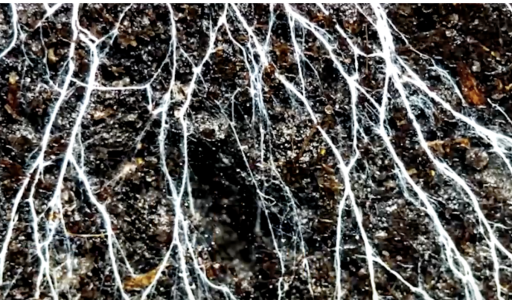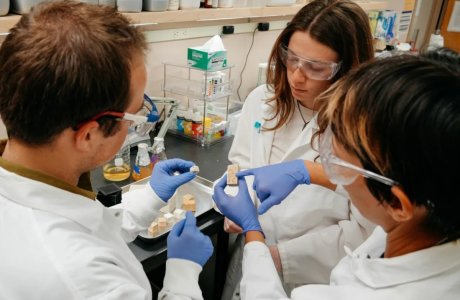Could your next home be made of mushroom? Scientists are exploring a surprising solution to sustainable building
By
Veronica E.
- Replies 0
What if your future home wasn’t just environmentally friendly—but actually alive?
It might sound like something out of a science fiction novel, but researchers are turning this idea into reality using fungi.
And while we're not talking about fairy-tale cottages just yet, this fascinating development could be a game changer in how we build for future generations.
At The GrayVine, we love sharing stories that blend innovation with real-world purpose.
This one has both—plus a touch of magic!

The science behind this trend comes from a natural material called mycelium, the root-like network of fungi that thrives beneath forest floors.
Mycelium is already known as a powerful recycler in nature—but now, scientists are using it to grow something much bigger: building materials.
A team at Montana State University, led by Dr. Chelsea Heveran, is exploring how to turn mycelium into a strong, lightweight, and even self-repairing alternative to traditional concrete.
And that could mean big things for both the environment and the way we think about housing.
To create these “living bricks,” researchers first grow dense mats of mycelium.
Then, they introduce a special bacteria—Sporosarcina pasteurii—that produces calcium carbonate, the same substance found in seashells and limestone.
This process, called biomineralization, hardens the fungi into a material that’s surprisingly tough, yet still biodegradable.
Even more remarkable?
The microbes inside the material can stay alive for weeks, which opens the door to features like self-healing walls and surfaces that can sense changes in their environment.
Not quite yet. These fungi-based materials are promising, but they still have limitations.
As Dr. Avinash Manjula-Basavanna of Northeastern University explains, "It's not stiffness that people are interested in when it comes to construction materials. It’s the strength, the load-bearing ability."
For now, researchers say these materials are best suited for smaller structures like garden sheds, temporary shelters, or one-story homes.
But with further development, they may one day support larger buildings—and even be used in space habitats for future astronauts.

It’s a fair question.
Some types of fungi can be a concern for people with allergies or respiratory conditions.
The good news is that most of the mycelium is killed before use, which greatly reduces health risks.
Still, scientists are conducting more testing to ensure the material is safe for everyday use.
Even if fungi-based homes aren’t mainstream yet, mycelium is already being used in other eco-friendly ways.
Companies are turning it into packaging, insulation, and even furniture.
It’s light, flame-resistant, and biodegradable—an exciting replacement for plastic in many industries.
NASA and other space agencies are also paying attention.
Since hauling heavy construction materials into space is costly, the idea of growing habitats on other planets using fungi could be a practical—and sustainable—solution.
You won’t find mycelium bricks at the local hardware store just yet.
Scientists still need to improve strength, conduct safety testing, and work through building regulations.
But the potential is there—and it’s gaining traction.
As interest in sustainable living grows, materials like mycelium could become an important part of the solution.
If you’ve watched the world change over the last few decades—from the moon landing to the rise of the internet—you know innovation can reshape our lives in surprising ways.
Fungi-based building materials may sound unusual today, but they’re part of a bigger movement toward eco-friendly, resilient, and even self-sustaining communities.
Imagine homes that can fix themselves, reduce pollution, and help protect the planet for your grandchildren and beyond.
That’s the kind of progress worth keeping an eye on!
Read next: Household item beats bleach for mold in your fridge—discover the secret!

Would you live in a house made of fungi? Does the idea intrigue you—or make you squirm? Have you seen other nature-inspired innovations that give you hope for the future? Share your thoughts in the comments—we’d love to hear your take!
It might sound like something out of a science fiction novel, but researchers are turning this idea into reality using fungi.
And while we're not talking about fairy-tale cottages just yet, this fascinating development could be a game changer in how we build for future generations.
At The GrayVine, we love sharing stories that blend innovation with real-world purpose.
This one has both—plus a touch of magic!

Researchers are exploring mycelium—part of the fungi family—as a sustainable building material that could help reshape the future of housing. Image Source: YouTube / Reuters.
Why fungi?
The science behind this trend comes from a natural material called mycelium, the root-like network of fungi that thrives beneath forest floors.
Mycelium is already known as a powerful recycler in nature—but now, scientists are using it to grow something much bigger: building materials.
A team at Montana State University, led by Dr. Chelsea Heveran, is exploring how to turn mycelium into a strong, lightweight, and even self-repairing alternative to traditional concrete.
And that could mean big things for both the environment and the way we think about housing.
Also read: You won't believe what this "loofah" actually was—a shocking and stunning discovery!
How does it work?
To create these “living bricks,” researchers first grow dense mats of mycelium.
Then, they introduce a special bacteria—Sporosarcina pasteurii—that produces calcium carbonate, the same substance found in seashells and limestone.
This process, called biomineralization, hardens the fungi into a material that’s surprisingly tough, yet still biodegradable.
Even more remarkable?
The microbes inside the material can stay alive for weeks, which opens the door to features like self-healing walls and surfaces that can sense changes in their environment.
Also read: Discovery in US bogs could revolutionize tuberculosis treatment!
Is it ready for real homes?
Not quite yet. These fungi-based materials are promising, but they still have limitations.
As Dr. Avinash Manjula-Basavanna of Northeastern University explains, "It's not stiffness that people are interested in when it comes to construction materials. It’s the strength, the load-bearing ability."
For now, researchers say these materials are best suited for smaller structures like garden sheds, temporary shelters, or one-story homes.
But with further development, they may one day support larger buildings—and even be used in space habitats for future astronauts.

Chelsea Heveran, the lead researcher at Montana State University in Bozeman, works alongside students Ethan Viles and Liv Aspholm as they prepare the biomineralized building material. Image Source: CNN / Maren Stubenvoll.
Also read: Why eating mushrooms daily might be a big mistake!
Are fungi bricks safe?
It’s a fair question.
Some types of fungi can be a concern for people with allergies or respiratory conditions.
The good news is that most of the mycelium is killed before use, which greatly reduces health risks.
Still, scientists are conducting more testing to ensure the material is safe for everyday use.
Also read: This appliance is dirtier than your toilet! Can you guess which one it is?
More than just building homes
Even if fungi-based homes aren’t mainstream yet, mycelium is already being used in other eco-friendly ways.
Companies are turning it into packaging, insulation, and even furniture.
It’s light, flame-resistant, and biodegradable—an exciting replacement for plastic in many industries.
NASA and other space agencies are also paying attention.
Since hauling heavy construction materials into space is costly, the idea of growing habitats on other planets using fungi could be a practical—and sustainable—solution.
Also read: This clothing item is filthier than you think—and you’re probably wearing it right now
So, when can we move in?
You won’t find mycelium bricks at the local hardware store just yet.
Scientists still need to improve strength, conduct safety testing, and work through building regulations.
But the potential is there—and it’s gaining traction.
As interest in sustainable living grows, materials like mycelium could become an important part of the solution.
If you’ve watched the world change over the last few decades—from the moon landing to the rise of the internet—you know innovation can reshape our lives in surprising ways.
Fungi-based building materials may sound unusual today, but they’re part of a bigger movement toward eco-friendly, resilient, and even self-sustaining communities.
Imagine homes that can fix themselves, reduce pollution, and help protect the planet for your grandchildren and beyond.
That’s the kind of progress worth keeping an eye on!
Read next: Household item beats bleach for mold in your fridge—discover the secret!
Key Takeaways
- Scientists are developing building materials using fungal mycelium and bacteria, offering a greener alternative to cement.
- The process creates a hardened, bone-like material that could one day be used in eco-friendly construction.
- Current limitations include strength, scalability, and safety, but the technology shows promise for smaller structures and even space habitats.
- Mycelium is already being used in packaging, furniture, and insulation—and may play a major role in future sustainable design.
Would you live in a house made of fungi? Does the idea intrigue you—or make you squirm? Have you seen other nature-inspired innovations that give you hope for the future? Share your thoughts in the comments—we’d love to hear your take!






